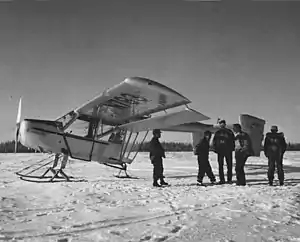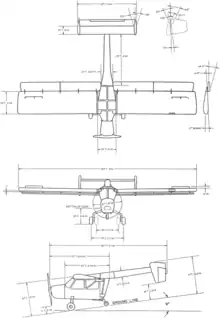Boeing L-15 Scout
The Boeing L-15 Scout or YL-15 was a small, piston engine liaison aircraft built by Boeing in very small numbers after World War II. It was a short take-off and landing (STOL) aircraft powered by a 125 hp Lycoming engine. The L-15 was an attempt by Boeing to expand its product line as World War II drew to a close, and Boeing's production of combat aircraft declined. Boeing decided against marketing the L-15 as a general aviation aircraft, and the twelve that were produced went to the United States Army for testing, then were transferred to the United States Fish and Wildlife Service in Alaska for various duties.
| L-15 Scout | |
|---|---|
 | |
| YL-15 (N783) of US Fish & Wildlife Service | |
| Role | Liaison aircraft |
| National origin | United States |
| Manufacturer | Boeing |
| First flight | 13 July 1947 |
| Number built | 12 |
Design
The scout was a conventional geared aircraft that was also tested on ski and float gear. The unique fuselage tapered sharply behind the pilot similar to a helicopter fuselage, with a high-mounted boom supporting the tail surfaces. The original design included a single vertical stabilizer, but two small downward-mounted stabilizers were used on production models. Spoiler-ailerons were used for roll control, and full length flaps were mounted on the trailing edge of the wings. The rear fuselage was all-window, and the tandem co-pilot could swivel the chair rearward.
Although its cruise speed was only 101 mph, the aircraft was rated to be towed by another aircraft at speeds up to 160 mph.[1]
Surviving aircraft
- 47-432 – YL-15 airworthy with Keith N. Brunquist of Wasilla, Alaska.[2][3]
Gallery
 YL-15 N4770C
YL-15 N4770C Undercarriage
Undercarriage Observer's seat
Observer's seat Wing
Wing Tail
Tail
Specifications (XL-15)

Data from Boeing Aircraft since 1916[4]
General characteristics
- Crew: Two (pilot and observer)
- Length: 25 ft 3 in (7.70 m)
- Wingspan: 40 ft 0 in (12.19 m)
- Height: 8 ft 8+1⁄2 in (2.654 m)
- Wing area: 269 sq ft (25.0 m2)
- Empty weight: 1,509 lb (684 kg)
- Gross weight: 2,050 lb (930 kg)
- Powerplant: 1 × Lycoming O-290-7 four-cylinder air-cooled horizontally-opposed engine, 125 hp (93 kW)
Performance
- Maximum speed: 112 mph (180 km/h, 97 kn)
- Cruise speed: 101 mph (163 km/h, 88 kn)
- Stall speed: 35 mph (56 km/h, 30 kn)
- Endurance: 2+1⁄4 hours normal, 5+1⁄2 hours with external fuel
- Service ceiling: 16,400 ft (5,000 m)
- Rate of climb: 628 ft/min (3.19 m/s)
See also
Aircraft of comparable role, configuration, and era
- Aero Ae 50
- Auster B.4
- I.S.T. XL-15 Tagak
- Miles M.68
- Praga XE-55
References
Notes
- Plane and Pilot. July 1967.
{{cite journal}}: Missing or empty|title=(help) - "FAA Registry [N4770C]". Federal Aviation Administration. U.S. Department of Transportation. Retrieved 6 March 2023.
- "Boeing YL-15 - Defying Physics". YouTube. 20 October 2017. Retrieved 6 March 2023.
- Bowers 1989, pp. 374–375.
Bibliography
- Bowers, Peter M. Boeing Aircraft since 1916. London: Putnam, Third edition 1989. ISBN 0-85177-804-6.
External links
- "Grasshopper's Eyes Widen" , March 1947, Popular Science article with explanation of unique features of L-15A
- "Eye For Ground Forces Fly As Low As 50 mph" , March 1947, Popular Mechanics good photo of rear observer's unique position
- "XL-15 Folds Up For A Tow" , February 1948, Popular Science middle of page
- Flight, November 20th 1947, page 573 bottom of page shows XL-15A on floats, with specification when operated as float plane
- "New Eyes For The Army Ground Forces" , October 1947, Popular Science US Army recruiting ad featuring L-15A
- "EAA video: Boeing YL-15 – Defying Physics" , EAA YouTube Published Oct 20, 2017